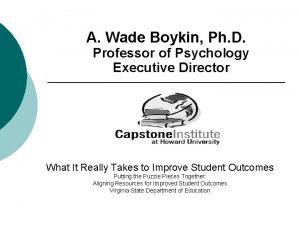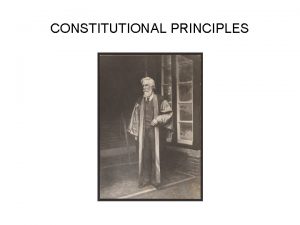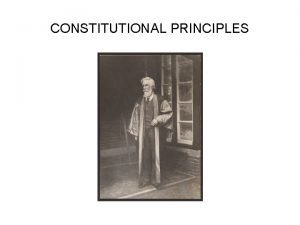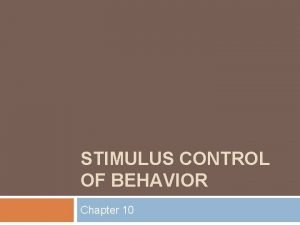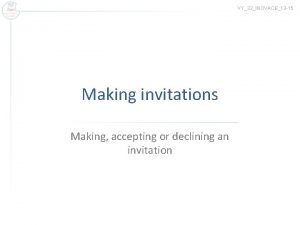Invitation To Psychology Carol Wade and Carol Tavris


























- Slides: 26

Invitation To Psychology Carol Wade and Carol Tavris Power. Point Presentation by H. Lynn Bradman Metropolitan Community College-Omaha Wade and Tavris © 2005 Prentice Hall 1

The Major Motives of Life: Love, Sex, Food, and Work Wade and Tavris © 2005 Prentice Hall 2

The Major Motives of Life: Love, Sex, Food, and Work • • The Social Animal: Motives for Love The Erotic Animal: Motives for Sex The Hungry Animal: Motives for Food The Competent Animal: Motives to Achieve • When Motives Conflict © 2002 Prentice Hall

Motivation • An inferred process within a person or animal that causes movement either toward a goal or away from an unpleasant situation. Wade and Tavris © 2005 Prentice Hall 4

The Social Animal: Motives for Love • The Varieties of Love • Gender, Culture, and Love Wade and Tavris © 2005 Prentice Hall 5

The Six Styles of Love • Eros – Romantic, passionate love • Ludus – Game-playing love • Storge – Affectionate, friendly love • Pragma – Logical, pragmatic love • Mania – Possessive, dependent, “crazy” love • Agape – Unselfish love Wade and Tavris © 2005 Prentice Hall 6

Triangle Theory of Love • Varieties of love occur because of differing combinations of three elements • Examples: Commitment – Liking: Intimacy alone – Companionate love: Intimacy + Commitment – Romantic love: Intimacy + Passion Wade and Tavris © 2005 Prentice Hall Intimacy Passion 7

The Erotic Animal: Motives for Sex • • The The Biology of Desire Psychology of Desire Culture of Desire Riddle of Sexual Orientation Wade and Tavris © 2005 Prentice Hall 8

The Biology of Desire • Hormones and Sexual Response • Arousal and Orgasm • The Evolutionary View Wade and Tavris © 2005 Prentice Hall 9

Attitudes Toward Chastity Wade and Tavris © 2005 Prentice Hall 10

The Psychology of Desire • Many Motives for Sex – Enhancement – Intimacy – Coping – Self-Affirmation – Partner Approval – Peer Approval Wade and Tavris © 2005 Prentice Hall 11

The Culture of Desire • Sexual Scripts: – Sets of implicit rules that specify proper sexual behavior for a person in a given situation, varying with the person’s age, culture, and gender. Wade and Tavris © 2005 Prentice Hall 12

The Riddle of Sexual Orientation • Psychological Versus Biological Explanations • Homosexuality and Politics Wade and Tavris © 2005 Prentice Hall 13

The Hungry Animal: Motives for Food • The Genetics of Weight • Culture, Psychology, and Weight • Weight and Health: Biology Versus Culture Wade and Tavris © 2005 Prentice Hall 14

The Genetics of Weight • Heaviness is not always caused by overeating. • Set Point: – The genetically influenced weight range for an individual, maintained by biological mechanisms that regulate food intake, fat reserves, and metabolism. Wade and Tavris © 2005 Prentice Hall 15

Culture, Psychology, and Weight • Diet and Exercise • Cultural Attitudes Wade and Tavris © 2005 Prentice Hall 16

Weight and Health: Biology Versus Culture • Bulimia: – An eating disorder characterized by episodes of excessive eating (binges) followed by forced vomiting or use of laxatives (purging). • Anorexia Nervosa: – An eating disorder characterized by fear of being fat, a distorted body image, radically reduced consumption of food, and emaciation. Wade and Tavris © 2005 Prentice Hall 17

The Competent Animal: Motives to Achieve • Goals and Aspirations • The Effects of Motivation on Work • The Effects of Work on Motivation Wade and Tavris © 2005 Prentice Hall 18

Goals and Aspirations • Goals improve motivation when: – The goal is specific – The goal is challenging but achievable – The goal is framed in terms of getting what is wanted rather than avoiding what is not wanted Wade and Tavris © 2005 Prentice Hall 19

Types of Goals • Performance Goals: – Goals framed in terms of performing well in front of others, being judged favorably, and avoiding criticism. • Mastery (Learning) Goals: – Goals framed in terms of increasing one’s competence and skills. Wade and Tavris © 2005 Prentice Hall 20

Mastery and Motivation • Children praised for being smart tend to lose the pleasure of learning and focus on how well they are doing. Wade and Tavris © 2005 Prentice Hall 21

The Effects of Motivation on Work • Self-Efficacy: – A person’s belief that he or she is capable of producing desired results, such as mastering new skills and reaching goals. • Need for Achievement: – A learned motive to meet personal standards of success and excellence in a chosen area. Wade and Tavris © 2005 Prentice Hall 22

Effects of Work on Motivation • Working conditions that increase job involvement, motivation, and satisfaction: – – – Work provides a sense of meaningfulness Employees have control over part of work Tasks are varied Company maintains clear and consistent rules Employees have supportive relationships with superiors and co-workers – Employees receive useful feedback – Company offers opportunities for growth Wade and Tavris © 2005 Prentice Hall 23

When Motives Conflict Wade and Tavris © 2005 Prentice Hall 24

Motivational Conflicts • Approach-Approach Conflict: – Equally attracted to two activities or goals. • Avoidance-Avoidance Conflict: – Choosing between the “lesser of the evils. ” • Approach-Avoidance Conflict: – One activity or goal has both positive and negative elements. • Multiple Approach-Avoidance Conflicts: – Several choices, each with advantages and disadvantages. Wade and Tavris © 2005 Prentice Hall 25

Maslow's Pyramid of Needs • Needs arranged in a hierarchy • Low-level needs must be meet before trying to satisfy higher-level needs • Esteem: Status, respect, power • Self-actualization: Fulfill one’s potential Wade and Tavris © 2005 Prentice Hall 26
 Elizabeth wade nhs
Elizabeth wade nhs Wade kerrigan husch blackwell
Wade kerrigan husch blackwell Wade carter attorney
Wade carter attorney The roe wade
The roe wade Organic chemistry wade
Organic chemistry wade Roe vs wade dissenting opinion
Roe vs wade dissenting opinion A wade boykin
A wade boykin Rethrog
Rethrog Sir william wade
Sir william wade Wade lipscomb
Wade lipscomb Felicia wade
Felicia wade Wade pearson
Wade pearson Wade degottardi
Wade degottardi Wade trappe
Wade trappe Sir william wade
Sir william wade Wade alexander phipps
Wade alexander phipps What was wade’s secret to mastering anorak’s almanac?
What was wade’s secret to mastering anorak’s almanac? Prtifo
Prtifo Roe vs wade summary
Roe vs wade summary Wade henning
Wade henning Lashley wade theory
Lashley wade theory Roe v wade summary
Roe v wade summary Professor derick wade
Professor derick wade Informal acceptance of invitation
Informal acceptance of invitation Dialogue about invitation birthday party
Dialogue about invitation birthday party Positive psychology ap psychology definition
Positive psychology ap psychology definition Deindividuation psychology definition
Deindividuation psychology definition






